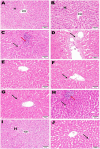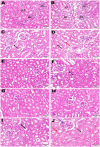The protective effect of various forms of Nigella sativa against hepatorenal dysfunction: underlying mechanisms comprise antioxidation, anti- inflammation, and anti-apoptosis
- PMID: 40432961
- PMCID: PMC12106032
- DOI: 10.3389/fnut.2025.1553215
The protective effect of various forms of Nigella sativa against hepatorenal dysfunction: underlying mechanisms comprise antioxidation, anti- inflammation, and anti-apoptosis
Abstract
Introduction: The liver and kidney are vital organs that are interconnected, dealing with detoxifying and excreting xenobiotics. They are constantly exposed to oxidative stress, which can cause hepatorenal dysfunction. This study compares two forms of Nigella sativa (NS), NS oil (NSO), and NS seeds (NSS), for the first time, in their ability to mitigate hepatorenal injury induced by azathioprine (AZA), exploring potential underlying mechanisms.
Methods: Group (1): negative control; Group (2): positive control received 15 mg/kg AZA orally. Groups (3, 4, and 5) received 100 mg/kg silymarin (standard reference), 500 mg/kg NSO, and 250 mg/kg NSS, respectively, and were subjected to the same dose of AZA. A one-way analysis of variance was conducted, followed by Mann-Whitney post-hoc analysis.
Results: Administration of AZA induced hepatorenal dysfunction, evidenced by dyslipidemia, elevations in serum liver enzymes, creatinine, urea, pro-inflammatory cytokines, and cytokeratin-18. Antioxidant enzymes in liver and kidney tissues were reduced, with an elevation in caspase-3 and caspase-9. Both forms of NS significantly balanced serum pro- inflammatory cytokines (14.33 ± 2.33, 15.15 ± 1.64 vs. 24.87 ± 1.87) pg/ml, interleukin-4 (16.72 ± 1.14, 15.95 ± 1.03 vs. 10.64 ± 1.04) pg/ml, and interleukin-10 (19.89 ± 0.69, 18.38 ± 0.38 vs. 15.52 ± 1.02) pg/ml, and downregulated cytokeratin-18 (210.43 ± 21.56, 195.86 ± 19.42 vs. 296.54 ± 13.94) pg/ml for NSO and NSS vs. the positive group, respectively. NSS enhanced liver antioxidant activity (P < 0.05), normalized liver enzymes (P < 0.05, P < 0.01) for alanine aminotransferase and aspartate aminotransferase, respectively, and significantly lessened dyslipidemia (P < 0.05). Liver caspase-3 and caspase-9 improved significantly with NSS, while kidney caspase-3 and caspase-9 improved with NSO. NSO increased kidney glutathione peroxidase and catalase (P < 0.01) and corrected creatinine and urea (P < 0.05). Histopathological observations confirmed the present data.
Discussion: Conclusively, NSO and NSS mitigated hepatorenal dysfunction responses to AZA through antioxidant, anti-inflammatory, and anti-apoptosis properties that underlie their protective performance. Interestingly, NSO surpassed NSS in restoring renal oxidative damage, while NSS provided better hepatic protection than NSO, suggesting NSO for patients with kidney dysfunction and NSS for those with liver problems.
Keywords: Nigella sativa oil; Nigella sativa seed; antioxidant; apoptosis; cytokeratin-18; cytokine; hepatorenal.
Copyright © 2025 Algheshairy, Alharbi, Almujaydil, Alhomaid and Ali.
Conflict of interest statement
The authors declare that the research was conducted in the absence of any commercial or financial relationships that could be construed as a potential conflict of interest.
Figures












Similar articles
-
Ameliorative Effect of Camel's Milk and Nigella Sativa Oil against Thioacetamide-induced Hepatorenal Damage in Rats.Pharmacogn Mag. 2018 Jan-Mar;14(53):27-35. doi: 10.4103/pm.pm_132_17. Epub 2018 Feb 20. Pharmacogn Mag. 2018. PMID: 29576698 Free PMC article.
-
Nigella sativa oil attenuates inflammation and oxidative stress in experimental myocardial infarction.BMC Complement Med Ther. 2024 Oct 7;24(1):362. doi: 10.1186/s12906-024-04648-2. BMC Complement Med Ther. 2024. PMID: 39375628 Free PMC article.
-
Oral administration of Nigella sativa oil ameliorates the effect of cisplatin on membrane enzymes, carbohydrate metabolism and oxidative damage in rat liver.Toxicol Rep. 2016 Feb 13;3:328-335. doi: 10.1016/j.toxrep.2016.02.004. eCollection 2016. Toxicol Rep. 2016. PMID: 28959553 Free PMC article.
-
Protective effect of Nigella sativa oil on cisplatin induced nephrotoxicity and oxidative damage in rat kidney.Biomed Pharmacother. 2017 Jan;85:7-15. doi: 10.1016/j.biopha.2016.11.110. Epub 2016 Dec 5. Biomed Pharmacother. 2017. PMID: 27930989
-
Nigella sativa L. and COVID-19: A Glance at The Anti-COVID-19 Chemical Constituents, Clinical Trials, Inventions, and Patent Literature.Molecules. 2022 Apr 25;27(9):2750. doi: 10.3390/molecules27092750. Molecules. 2022. PMID: 35566101 Free PMC article. Review.
References
-
- Barbara S. Inflammatory bowel disease and male fertility. LIJ Heal Syst. (2010) 516:734–850.
LinkOut - more resources
Full Text Sources
Research Materials
Miscellaneous

